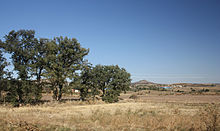|
East Thrace   East Thrace or Eastern Thrace,[a] also known as Turkish Thrace or European Turkey, is the part of Turkey that is geographically a part of Southeast Europe.[1] It accounts for 3.03% of Turkey's land area and 15% of its population. The largest city is Istanbul, which straddles the Bosporus between Europe and Asia. East Thrace is of historic importance as it is next to a major sea trade corridor and constitutes what remains of the once-vast Ottoman region of Rumelia. It is currently also of specific geostrategic importance because the sea corridor, which includes two narrow straits, provides access to the Mediterranean Sea from the Black Sea for the navies of five countries: Russia, Ukraine, Romania, Bulgaria, and Georgia. The region also serves as a future connector of existing Turkish, Bulgarian, and Greek high-speed rail networks. Due to the guest worker agreement with Turkey and Germany, some Turks in Germany originally come from Eastern Thrace, mostly from the Kırklareli Province.[2] DefinitionEast Thrace sometimes refers to the eastern part of the historical region of Thrace. It is also used for the part of Thrace that is inside Turkey. The area includes all the territories of the Turkish provinces of Edirne, Tekirdağ and Kırklareli, as well as those territories on the European continent of the provinces of Çanakkale and Istanbul. The land borders of East Thrace were defined by the Treaty of Constantinople (1913) and the Bulgarian-Ottoman convention (1915) and were reaffirmed by the Treaty of Lausanne. GeographyEast Thrace has an area of 23,757 km2 (9,172 sq mi), 3.1% of Turkey's internal area; the population density is around 515/km2, compared to about 98/km2 for Asiatic Turkey. The two continents are separated by the Dardanelles, the Bosphorus (collectively known as the Turkish straits) and the Sea of Marmara, a route of about 361 km (224 mi). The southernmost part of eastern Thrace is called the Gallipoli peninsula. East Thrace is bordered on the west by Greece and on the north by Bulgaria, with the Aegean Sea to the southwest and the Black Sea to the northeast.[3][4] 
ClimateThe area has a hybrid mediterranean climate/humid subtropical climate on the Aegean Sea coast and the Marmara Sea coast, and an oceanic climate on the Black Sea coast. Summers are warm to hot, humid and moderately dry whereas winters are cold and wet and sometimes snowy. The coastal climate keeps the temperatures relatively mild. HistoryEast Thrace was the setting for several important events in history and legend, including:
During the Russo-Turkish War (1877–1878) and the Balkan Wars (1912–1913), Muslim Muhacir of various ethnic groups from the former Ottoman territories in the Balkans, were forced to flee toward eastern Thrace through expulsions, violence and massacres, followed by further emigration caused by the 1923-24 Population exchange between Greece and Turkey.[5] Prior to that the distribution of ethnoreligious groups in the local sanjaks was as follows:
The Muslim millet was recorded as Turkish, while the church members of the Ecumenical Patriarchate were recorded as Greek. In the past century, modern East Thrace was the main component of the territory of the Adrianople Vilayet, which excluded the Constantinople Vilayet, but included West Thrace and parts of the Rhodopes and Sakar. A publication from December 21, 1912, in the Belgian magazine Ons Volk Ontwaakt (‘Our Nation Awakes’) estimated 1,006,500 inhabitants in the vilayet:[7]
21st century East Thrace constitutes what remains of Turkish Rumelia, which once stretched as far north as Hungary and as far west as Bosnia. Rumelia was lost piecemeal from 1699 onwards, until in 1912 the bulk of it was lost in the First Balkan War. Some small regains were made during the Second Balkan War. The current borders were set forth in the Treaty of Constantinople (1913) and the Bulgarian–Ottoman convention (1915), and were reaffirmed in the Treaty of Lausanne. DemographicsThe majority of the Muslim population are descendants of the Muhacir, such as Balkan Turks, Bulgarian Turks in Turkey, Amuca tribe, Albanians in Turkey, Bosniaks in Turkey, Gajal, Pomaks in Turkey, Megleno-Romanians, Vallahades, Crimean Tatars in Turkey, Circassians in Turkey, and Romani people in Turkey live there.[8] Attractions and festivalsSome tourist attractions are the Edirne Museum, Complex of Sultan Bayezid II Health Museum, Treaty of Lausanne Monument and Museum, Kırklareli Museum, and the Edirne Palace. There are several historical religious buildings, such as the Selimiye Mosque, Üç Şerefeli Mosque, Old Mosque, Muradiye Mosque, and the Grand Synagogue of Edirne. There are also historical bridges, such as the Fatih Bridge, Meriç Bridge, and Uzunköprü Bridge. Natural attractions include the Lake Gala National Park, İğneada Floodplain Forests National Park, Lake Saka Nature Reserve, and Dupnisa Cave. Since 1360, the oil wrestling tournament Kırkpınar is held annually near Edirne; usually in late June. The Romani festival Kakava is held annually in Edirne and Kırklareli. PoliticsIn Eastern Thrace the Republican People's Party and Kemalism traditionally dominate.[9][10][11] A scandal in Turkey was triggered by the statement of CHP Büyükçekmece Council Member Eren Savaş in May 2023 that Eastern Thrace should be separated from Turkey.[12][13][14] Gallery
See also
NotesReferences
Further reading
|
||||||||||||||||||||||||||||||||||||||||||||||||||||||||||||||||||||||||||||||||||||||||||||||||||||||||



